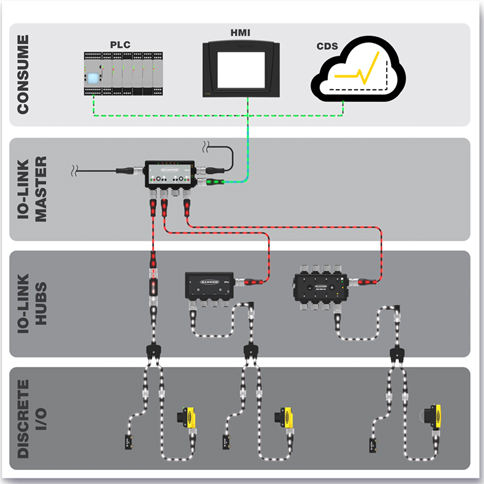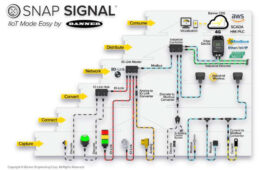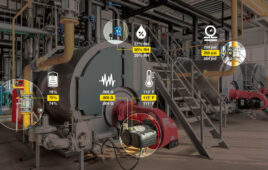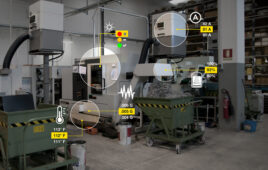
An open global standard for bi-directional serial communication among sensors and other devices, IO-Link provides simplified installation, automated parameter setting, and expanded diagnostics. Because these systems use an open standard, IO-Link enabled sensors, hubs, masters, and other devices can be integrated into almost any fieldbus or automation system.
IO-Link systems have many advantages and abilities, including standardized wiring, remote configuration, simple device replacement, advanced diagnostics, remote monitoring, and increased data availability. Combined, these capabilities result in:
- Overall reduced costs
- Increased process efficiency
- Improved machine availability
- Higher-quality output
Calculating Overall Equipment Effectiveness, or OEE, is aided by data from IO-Link devices. This calculation takes availability, performance, and quality into account. Availability considers events that decrease total runtime, especially unplanned stoppages. Performance takes into consideration the speed of the manufacturing process as it is running. Quality refers to parts or products that do not meet acceptable standards and must be scrapped or reworked, which wastes time.
Evaluating OEE provides actionable insights into the sources of waste in a manufacturing operation. Reducing this waste, and improving OEE, requires visibility into where and when inefficiencies occur, all the way down to the sensor level. Accessing performance and runtime data from IO-Link sensors and indicators is essential for calculating OEE and determining how to improve the efficiency of machines, processes, and people.
Reduced Costs
There are many ways in which IO-Link devices can help operations be more cost-effective. Since IO-Link devices send serial signals, they can use standard unshielded three-pin M12 cables. These readily available cordsets are cost-effective and install quickly, varying only by length. Standardized cabling also eliminates wiring and pinout errors and reduces installation time.
IO-Link devices are designed for simple device replacement without requiring extensive technical knowledge. With Data Storage mode, sensor device configuration can be saved on a port of the IO-Link master. If a sensor is damaged, even an untrained operator can quickly swap the damaged sensor with a new one. The correct device configuration is loaded automatically, and the new sensor is ready to go. No manuals, configuration documentation, or firmware updates are needed.
Another cost-reduction tactic made possible by IO-Link technology replacing passive junction blocks with stackable space-saving IO-Link hubs. This method simplifies connections by sending IO-Link signals back to one IO-Link Master, which aggregates and outputs all signals via a single Ethernet connection to a control cabinet. It reduces wiring, cost, installation and commissioning time, complexity, and allows for a smaller control cabinet. Hundreds of individual cable runs to a control cabinet can be replaced with six Ethernet cables.
Users with existing devices can gain the benefits of IO-Link without the cost of replacing their sensors. Banner IO-Link converters take signals from legacy devices and change them for use in an IO-Link system. This gives operators access to sensor-level data without having to completely retrofit expensive and complicated machinery.

Increased Process Efficiency and Machine Availability
With their ability to communicate and share data and operate seamlessly across industrial networks, IO-Link devices can provide deep insights into machine health, reliability, and productivity.
For starters, IO-Link devices can be used to read and change device parameters remotely through control system software, enabling fast configuration and commissioning that saves time and resources. IO-Link sensors can accommodate multiple recipes that can be quickly and dynamically changed from the control system as needed, such as during product changeover. For example, a line that runs products of different sizes at different times will need sensors’ distance thresholds changed, a feat easily accomplished remotely.
During changeover, the IO-Link master writes the new threshold to the sensors without an operator being present to teach the sensors. This shaves significant time off sensor configuration during changeover, reducing downtime while increasing productivity and throughput. It also allows machines to accommodate greater product diversity.
Using real-time sensor data, IO-Link communication can establish alarms and predictive maintenance tasks. For example, sensors like the Q4X laser distance sensor with IO-Link provide excess gain data via IO-Link, which can be used to identify when a sensor requires cleaning (as dust and other particles accumulate on the sensor lens, excess gain decreases). Alerts can be set up so sensors can be cleaned before the buildup of debris impacts sensing ability. Device connection issues are also reported in real time, allowing them to be resolved promptly. For operations with many sensors grouped together, IO-Link’s discovery function can indicate the specific sensor that needs attention. By making the sensor flash it can easily be identified and the issue addressed quickly.
Switching to an IO-Link system can significantly improve the ways in which operators and machines interact company-wide, leading to enhanced cost efficiency, process efficiency, and greater machine uptime.
Sponsored content by Banner Engineering
Filed Under: Banner Engineering Sponsored Content



